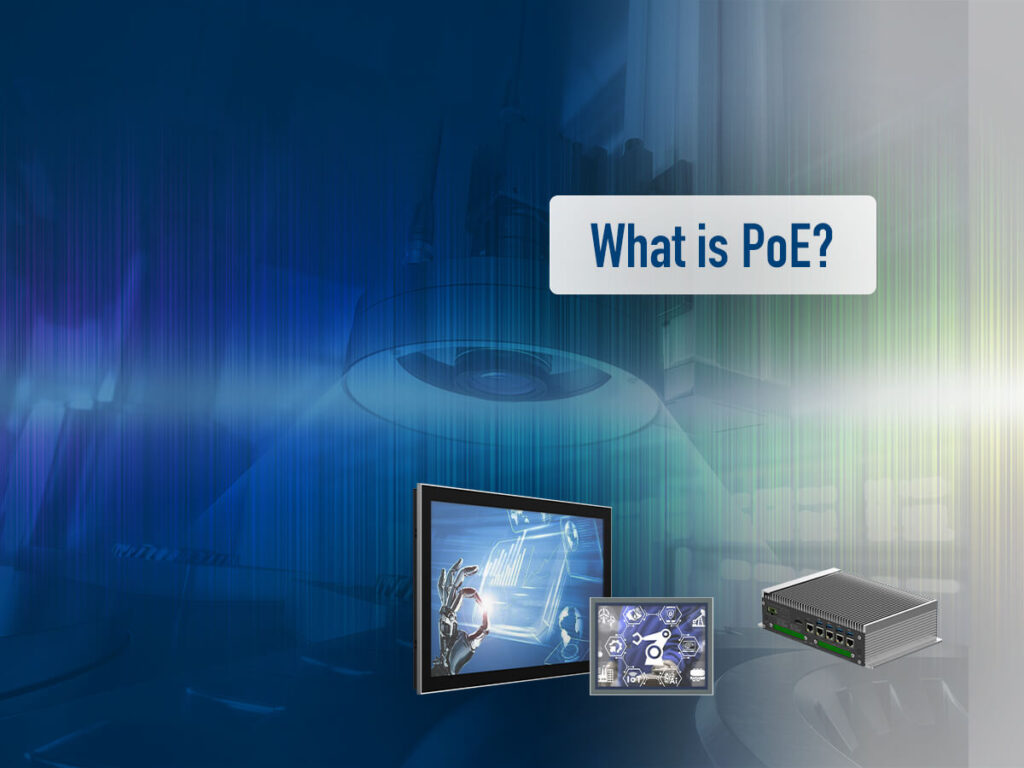A remote Ethernet device needs two things: power and Ethernet. You might think that this also means two cables, one to carry the power to run the thing, and another cable for the data. But no for a PoE solution.
Power over Ethernet (PoE) transmits electric power with data simultaneously over data pairs on one single cables. PoE provides both data connection and operating power to industrial, IoT and even commercial electronics devices. The single network cable transfers both data and power to the device making installation very simple.
The thinking required to decide how to power your computer is probably limited to choosing which power supply (PSU) you will select. But to power industrial or IoT devices is frequently much more complicated. The low power consumption of industrial computers is a nice feature for the fields. That is to say, the way you provide power to the system can make differences on system longevity, costs and ultimately project success.
How PoE Works?
To use Power Over Ethernet (PoE), a popular alternative to power devices they need over the ethernet cable that’s already connected. PoE solution has become a popular choice for industrial system operator, to reduce the number of wires they need in their infrastructure to ensure reliable power delivery.
Historically, PoE was implemented by simply hooking extra lines up to a DC power supply. PoE systems are composed of Power Sourcing Equipment (PSE) and Powered Devices (PD). PSEs provide a direct current to a standard ethernet cable, which transfers it to a PD at distances up to 100 meters.
The Institute of Electrical and Electronics Engineers (IEEE) defines multiple Power over Ethernet standards for a variety of power levels. The most common of these standards are IEEE 802.3af and IEEE 802.3at. These standards provision up to 15.4W and 25.5W (respectively) to downstream PDs over two of the data pairs.
All PSE devices are capable of powering downstream devices with a power level equal to or lower than the sourcing capability. This means that an IEEE 802.3at compliant PSE can power both IEEE 802.3at and IEEE 802.3af devices. The capabilities of the PSE must be selected based on the requirements of the downstream PD devices.

Why Use PoE?
Power over Ethernet brings many advantages to the industrial system user:
– Time and cost savings – by reducing the time and expense of having electrical power cabling installed. Network cables do not require a qualified electrician to fit them, and can be located anywhere.
– Flexibility – without being tethered to an electrical outlet, devices such as IP cameras and wireless access points can be located wherever they are needed most, and repositioned easily if required.
– Safety – POE delivery is intelligent, and designed to protect network equipment from overload, underpowering, or incorrect installation.
– Reliability – POE power comes from a central and universally compatible source, rather than a collection of distributed wall adapters. It can be backed-up by an uninterruptible power supply, or controlled to easily disable or reset devices.
– Scalability – having power available on the network means that installation and distribution of network connections is simple and effective.
What devices use PoE?
Equipment built to the 2003 PoE standard initially delivered enough power for most applications but could not provide enough power for other types of mounted technology, such as video surveillance cameras. Over the years, the Institute of Electrical and Electronics Engineers (IEEE) and several vendors have attempted to address the power issue, but interoperability problems have persisted.
POE has many applications, but the three key areas are:
VoIP phones – the original POE application. Using POE means phones have a single connection to a wall socket, and can be remotely powered down, just like with the older analog systems.
IP cameras – POE is now ubiquitous on networked surveillance cameras, where it enables fast deployment and easy repositioning.
Wireless – WIFI and Bluetooth APs and RFID readers are commonly PoE-compatible, to allow remote location away from AC outlets, and relocation following site surveys.
Examples of PoE in industrial application
Power over Ethernet (PoE) is a technology with an increasing number of products on the market. Small devices with low power consumption are getting more equipped with PoE. Typically, let us to describe a machine vision application during implement the PoE technology.
Machine vision is becoming more popular in factory automation. In addition to reading codes, cameras can also identify objects, conduct quality tests and control processes. Because of these quality tests and control of processes, there is real demand to have a 100% quality check for the production line
A vision camera simply delivers a raw image of an object. Most modern vision cameras come in a very small footprint with all electronics, including the interfaces, located in a small housing. The electronic system has to be able to capture, process and transmit uncompressed video frames at high frame rates and resolutions. Gigabit Ethernet is a great way to transmit high data rates, and it still need power for vision cameras. Then, Industrial computing hardware solution & products with PoE will be a simple and effective way to combine power and high-speed data connection in one cable for machine vision applications.
How TAICENN Can Help
As an industrial computing hardware solution provider & manufacturer, TAICENN technology has helped customers to create a wide range of innovative solutions utilizing Power over Ethernet. TAICENN’s Industrial Box PCs TBOX-36×0 series and Industrial modular touch Panel PC TPC-DCP series offer industrial computing solution with PoE to make customers’ experiences more efficient. If you are looking for a PoE industrial computing solution, check out Taicenn’s product line.
Write at the end
As the Industrial Internet of Things (IIoT) expands, the number of PoE applications continue to increase as well. PoE is heavily used in IP camera and wireless projects. It’s ubiquitous in surveillance applications, where it enables fast setup and deployment. Industrial computers with PoE feature shall be used in more and more industrial applications.











